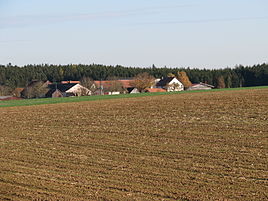Hundszell (Thalmässing)
|
Hundszell
Thalmässing market
Coordinates: 49 ° 3 ′ 34 ″ N , 11 ° 15 ′ 30 ″ E
|
|
|---|---|
| Height : | 549 m |
| Residents : | 10 (Jan. 2, 2018) |
| Postal code : | 91177 |
| Area code : | 09173 |
|
Hundszell
|
|
Hundszell is a district of the market Thalmässing in the district of Roth in the administrative region of Middle Franconia in Bavaria .
location
Hundszell is located in the southern part of Hilpoltsteiner Land at about 549 meters above sea level on the right of the Thalach on the Jura plateau of the southern Franconian Jura, southeast of Landersdorf . The field size is 97 hectares .
Place name interpretation
The part of the name "-zell" refers to a spiritual foundation, whose (first?) Administrator with the personal name "Hunt" gave the wasteland its name.
history
Hundszell first appears in a document in 1395. Even if Ulrich Utz from "Hunczell" is mentioned in the document, the wasteland should not have been a noble residence, especially since the citizens of Greding appear as sealers of the document next to Heinrich von "Mörspach" . Hundszell was founded by a monastery or by the diocese of Eichstätt. The landlord of the wasteland became the cathedral chapter of Eichstätt, the high jurisdiction was held by the Margravial-Ansbach Oberamt Stauf-Landeck. In 1535 a "Steffan Peyrn" from Hundszell "committed a devaluation"; the murder was atoned for in 1546.
With the implementation of the Reformation in the Margraviate of Ansbach, the cathedral capital subjects in Hundszell also had to accept the Lutheran faith and thus no longer belonged to the parish (Groß) Hebing , but to the parish of St. Michael in Thalmässing. The cathedral chapter continued to exercise rulership in the village and community, once again confirmed by the recess of 1736 between the Eichstätt monastery and the principality of Ansbach.
While Hundszell still consisted of two properties (a two-thirds and a third courtyard) towards the end of the Old Empire , around 1800, three properties / residential buildings were counted in 1900 and 1950, and again only two residential buildings in 1961.
In the new Kingdom of Bavaria (1806) Hundszell became part of the Waizenhofen tax district . On August 17, 1818, the rural community of Landersdorf was formed, to which, in addition to the two parish villages Landersdorf and Göllersreuth, the wastes Feinschluck , Hundszell and Kätzelmühle belonged. From October 1, 1809, this community was assigned to the Raitenbuch regional court , and from 1812 to the Greding regional court .
In 1875, seven horses and 33 cattle were kept in Hundszell. The children went to school in Landersdorf, today they attend the elementary school in Thalmässing.
On July 1, 1971, the municipality of Landersdorf and thus the hamlet of Hundszell was incorporated into the Thalmässing market.
Population development
- 1818: 14 (2 "fireplaces" = households, 2 families)
- 1823: 11 (2 courtyards)
- 1846: 19 (2 houses, 2 families)
- 1871: 14 (11 buildings)
- 1900: 20 (3 residential buildings)
- 1937: 13 Protestants, no Catholics
- 1950: 24 (3 yards)
- 1961: 13 (2 residential buildings)
- 1970: 10
- 2015: 9
monument
The old building of the Hundszell 1 farmhouse, a two-storey hipped roof building , the door frames of which is marked 1845, is considered a monument .
See the list of architectural monuments in Hundszell
traffic
Hundszell can be reached via a communal road from Landersdorf in a southerly direction; Landersdorf is on the district road RH 33.
The 120.9 kilometer Allersberg - Allersberg circular hiking trail, which also leads through Hundszell, has existed since 1997.
literature
- Wolfgang Wiessner: Historical Atlas of Bavaria. Part Franconia, series I, issue 24: Hilpoltstein. Munich 1978
- Gerhard Hirschmann: Historical Atlas of Bavaria. Part of Franconia. Row I, Issue 6. Eichstätt. Beilngries-Eichstätt-Greding. Munich 1959
Web links
Individual evidence
- ↑ Thalmässing
- ↑ Wiessner, p. 18; Michael Bacherler: The settlement names of the diocese of Eichstätt . In: Collection sheet of the Histor. Eichstätt Association, 38 (1923), p. 41
- ↑ Wiessner, p. 32
- ↑ Wiessner, p. 18
- ↑ Wiessner, p. 32; Collecting sheet of the Histor. Eichstätt Association 45 (1930), p. 108
- ^ Wiessner, p. 126
- ↑ Hirschmann, p. 35
- ↑ Collection sheet of the Histor. Eichstätt Association 6 (1891), p. 39
- ↑ Hirschmann, p. 35 f.
- ↑ Hirschmann, p. 39; Recess Between The Prince. Hohen Stifft Eystätt And The Hoch-Fürstl. Hauß Brandenburg-Onolzbach, from 22nd and 23rd August, Anno 1736, p. 25
- ↑ Wiessner, p. 32; Hirschmann, p. 114; Official directory for Bavaria. Territorial status on October 1, 1964 with statistical information from the 1961 census , Munich 1964, column 796
- ↑ Hirschmann, p. 228
- ↑ Kgl. Statistical Bureau in Munich (edit.): Complete list of localities of the Kingdom of Bavaria , Munich 1876, column 1163
- ^ [1] Website of the Thalmässing market
- ↑ Alphabetical index of all the localities contained in the Rezatkreise ... , Ansbach 1818, p. 44
- ↑ Hirschmann, p. 228
- ^ Eduard Vetter: Statistical handbook and address book of Middle Franconia in the Kingdom of Bavaria . Ansbach 1846, p. 121
- ↑ Kgl. Statistical Bureau in Munich (edit.): Complete list of localities of the Kingdom of Bavaria , Munich 1876, column 1163
- ^ Locations directory of the Kingdom of Bavaria with an alphabetical register of locations , Munich 1904, column 1224
- ^ Franz Xaver Buchner: The diocese of Eichstätt. Volume I: Eichstätt 1937, p. 415
- ↑ Hirschmann, p. 228
- ^ Official register of places for Bavaria. Territorial status on October 1, 1964 with statistical information from the 1961 census , Munich 1964, column 796
- ↑ Official directory for Bavaria , vol. 1978 = 380, Munich 1978, p. 167
- ^ [2] Website of the Thalmässing market
- ↑ [3] Description on fraenkischer-albverein.de

